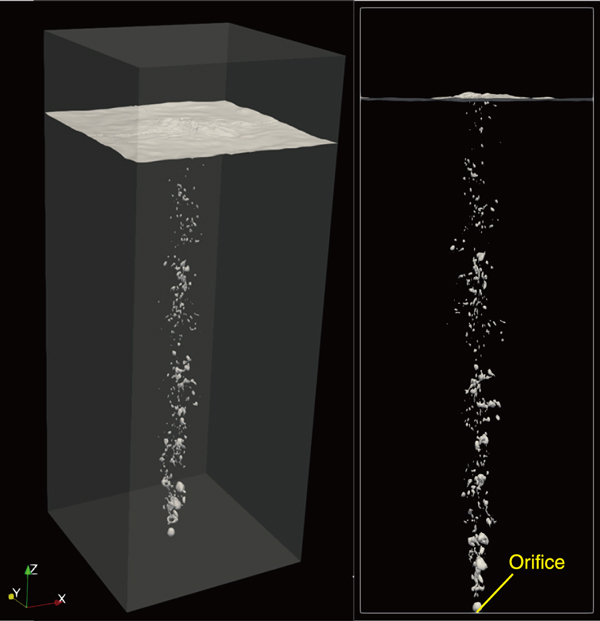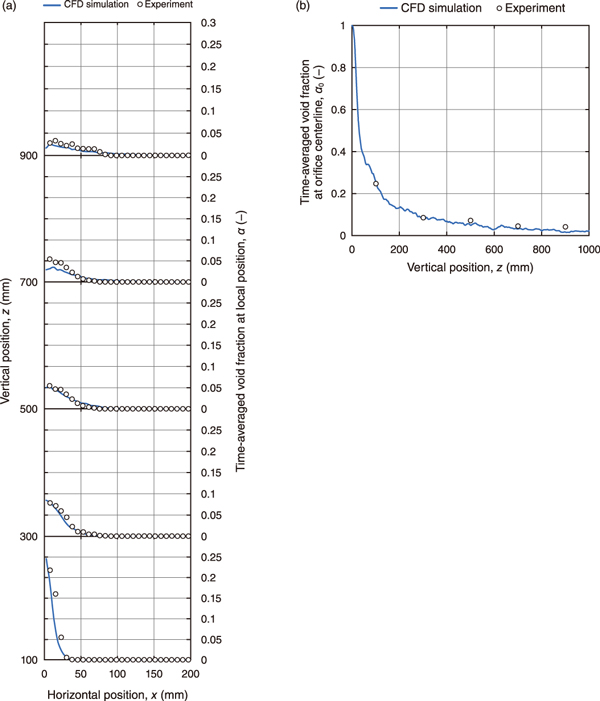
Fig.1 Bubble swarm behavior

Fig.2 Time-averaged void fraction (gas volume fraction) distribution
Pool scrubbing is one of the measures to reduce the release of particulate radioactive materials (aerosols) to the environment in the event of severe accidents in a nuclear reactor. Pool scrubbing is a wet filtering method that removes particles by transferring the aerosol contained in the bubbles from the gas phase to the liquid phase. This process is applied, for example, in the suppression pool of boiling water reactors, the secondary side of steam generators in pressurized water reactors, and filter vent systems.
During pool scrubbing, large bubbles (globules) formed by gas injection disintegrate into bubble swarms and finally reach the liquid surface of the pool. Since particle migration in a bubble is strongly affected by bubble hydrodynamics behavior, many phenomena are predicted and modeled by numerical analysis in parallel with experimental studies to understand bubble behavior. Computational Fluid Dynamics (CFD), one of the numerical analysis methods, reproduces realistic bubbly flows and can potentially obtain information that is difficult to measure experimentally.
In this study, we adopted the Simple Coupled Volume Of Fluid with Level Set (S-CLSVOF) method, which combines the VOF method with the LS method, to track the gas-liquid boundary surface (interface). The VOF method is adopted to specify the interface position by transporting the gas-liquid volume fraction (VOF function). Still, since the volume fraction does not have information on the interface gradient, the LS function was used to reproduce a smooth interface. The LS function can express the inclination of the interface with a distance function that represents the shortest distance (normal vector) to the interface. Thus, taking advantage of the strengths of both methods, the VOF method is used to track the entire bubble, while the LS method is used to analyze the interface curvature and normal vector. Fig.1 shows the bubble swarm behavior simulated by the S-CLSVOF method. The air injected through a circular orifice (a hole) at the center of the bottom surface of the pool forms a globule, which then detaches from the orifice. The detached bubbles form bubble swarms while repeatedly breaking up and coalescing, and small bubbles in a swarm rotate about an axis and rise as a whole, spreading outward conically.
We compared the analytical results of the void fraction (gas volume fraction) with the existing experimental results* (Fig.2) to validate the simulation results. The void fraction immediately after injection (at z = 100 mm) has a peak at 0.25 (Fig.2(a)). As the bubbles approach the liquid surface of the pool (at z = 1000 mm), the void fraction decreases and spreads radially (Figs.2(a) and (b)). The simulation results agree with the experimental results, confirming that the bubble swarm can be accurately predicted.
This study demonstrated that CFD simulation could potentially complement experiments for validating and predicting parameters that are difficult to measure experimentally, including interfacial area concentration and bubble rise velocity. In the future, we aim to provide data for the validation and improvement of severe accident codes used in nuclear safety regulations.
(Yuria Okagaki)
*Abe, Y. et al., Bubble Dynamics with Aerosol During Pool Scrubbing, Nuclear Engineering and Design, vol.337, 2018, p.96-107.